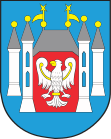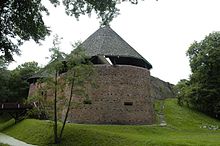Międzyrzecz
| Międzyrzecz | ||
|---|---|---|

|
|
|
| Basic data | ||
| State : | Poland | |
| Voivodeship : | Lebus | |
| Powiat : | Międzyrzecz | |
| Gmina : | Międzyrzecz | |
| Area : | 10.26 km² | |
| Geographic location : | 52 ° 27 ' N , 15 ° 35' E | |
| Height : | 51 m npm | |
| Residents : | 17,994 (June 30, 2019) | |
| Postal code : | 66-300 | |
| Telephone code : | (+48) 95 | |
| License plate : | FMI | |
| Economy and Transport | ||
| Street : | S3 ( E 65 ) | |
| Rail route : | PKP line 3 | |
| Wierzbno – Rzepin | ||
| Next international airport : | Poznan-Ławica | |
Międzyrzecz [ mʲɛnˈʣɨʒɛʧ ] ( German Meseritz ) is a city in the Polish Lubusz Voivodeship . It is the seat of the town-and-country municipality of the same name with 24,942 inhabitants and the district town of the Międzyrzecki powiat ( Meseritz district ), which roughly corresponds to the earlier district of Meseritz (borders from 1920).
Geographical location
The city is located on the Obra , around 88 kilometers east of Frankfurt (Oder) or Kostrzyn nad Odrą (Küstrin) and around 48 kilometers southeast of Gorzów Wielkopolski (Landsberg an der Warthe) . The Nietoperek nature reserve is located in the urban area .

history
The first historical mention of the place as an abbey "meserici" comes from the year 1005 in the description of a battle between Bolesław I the Brave and King Henry II by Thietmar von Merseburg . The place was strategically important because it was on the routes from Gnesen to Magdeburg and from Stettin to Breslau and Krakow . In 1094 the Poles recaptured the “ castle ” at the confluence of the Packlitz and Obra from the Pomerania . On January 29, 1230 the Cistercian monastery Paradies was officially founded, which was settled by monks from the Brandenburg monastery Lehnin . The Wielkopolska Chronicle of the Poznan bishop Bogufał mentioned the place as a city in 1248 in connection with a decree of the Germans of Meseritz ( Theutunicis de Medzyrzecz ). A town charter does not exist. In 1474 the place was destroyed by Matthias Corvinus , but rebuilt. Casimir IV confirmed the city rights of Meseritz in 1485. In 1606 a great fire raged in the city. In the Swedish Wars 1655-1660 and 1700-1721 the place was devastated several times.
With the Second Partition of Poland , the place fell to Prussia in 1793 . On November 26, 1806, Napoleon was in the city and an assassination attempt was planned. In 1807 the place came to the Duchy of Warsaw . The inhabitants declined during this period even further to 3500. After the war of liberation was Meseritz by the Congress of Vienna in 1815 to Prussia and was on January 1, 1818 the Prefecture of the same district in the province of Posen . At the 1905 census, the city had 5800 inhabitants, including 1,859 Catholics and 171 Jews . In 1900, 20.2% of the population in the entire district stated Polish as their mother tongue. Between 1919 and 1938 the city and district of Meseritz belonged to the province of Grenzmark Posen-West Prussia and, after its dissolution on October 1, 1938 to 1945, to the province of Brandenburg .
At the beginning of the 20th century, Meseritz had a Protestant church, an old Lutheran church, a Catholic church, a synagogue , a preparatory institute , a grammar school and was the seat of a regional court . In the time before the First World War , Meseritz became the junction for a total of five railway lines. In 2008 only two of them were still in use. EU funds are currently being used to restore the railway line from the Jordan Paradise.
Even before the Second World War , the German Wehrmacht had built the bunkers of the “Grenzschutzbefestigungsanlage III” (“ earthworm camp ”) in the nearby Nipter in connection with the “ Oder-Warthe-Bogen fortress front ”. This system had a total length of about 65 kilometers and was equipped with a 30-kilometer connecting tunnel.
In the Obrawalde sanatorium, which was built in 1904, around one hundred to one thousand people were systematically murdered under the guise of euthanasia during the Second World War . In the first of the so-called “doctor trials”, a doctor and a nurse from the institution were found guilty of the murder of at least 100 people in Berlin on March 25, 1946, sentenced to death and executed in January 1947.
After the invasion of the Red Army on January 31, 1945, the city was placed under Polish administration. Then began the immigration of Polish migrants, some of whom came from areas conquered by Poland after the First World War east of the Curzon Line . The majority of the German population was initially forced out of their houses and apartments by the newcomers and soon afterwards was driven out by the local Polish administrative authorities . The German city of Meseritz was renamed Międzyrzecz .
The city became the seat of a powiat on March 15, 1945 and from July 7, 1945 belonged to the Poznan Voivodeship , from 1950 to 1975 to the Zielona Góra Voivodeship and then to the Gorzów Voivodeship until 1999 . In 1994 the town hall was renovated. In 1997 the eagle in the city coat of arms, which had been provided with the Prussian insignia in 1924 , was replaced by the Polish one. In 1999 the place became the seat of a powiat again due to another administrative reform.
Population numbers
- 1800: 3,406, including 563 Jews
- 1837: 4,589
- 1861: 4.910
- 1875: 4.818
- 1880: 5.169
- 1890: 5,167, including 3,417 Protestants, 1,490 Catholics and 260 Jews
- 1905: 5,800, including 1,859 Catholics and 171 Jews
- 1933: 9.307
- 1939: 10,848, including 6,713 Protestants, 3,818 Catholics, 79 other Christians and 79 Jews
local community
The town itself and 18 villages with school boards belong to the town-and-country municipality (gmina miejsko-wiejska) Międzyrzecz. It has an area of 315 km².
Partnerships
- Andrésy (France, 1997)
- Bad Freienwalde (Germany, May 4, 2001)
- Berlin district of Charlottenburg-Wilmersdorf (Germany, October 23, 1993)
- Halderberge (Netherlands, 1988)
- Haren (Germany, October 24, 1991)
- Vlagtwedde (Netherlands, October 24, 1991)
Attractions
- Castle (13th century, now a museum)
- Church of St. John the Baptist (15th century)
- Town hall (16th century)
- Church of Saint Adalbert (19th century)
- Synagogue , built between 1825 and 1827 (see also Jewish cemetery (Międzyrzecz) )
- Fire Brigade Museum "Colonel Leon Kiszmanowicz" (in Kęszyca Leśna)
Personalities
- Born in Meseritz
- Christian Samuel Theodor Bernd (1775–1854), linguist and heraldist
- Friedrich von Flatow (1820–1892), Prussian general of the infantry, director of the War Academy
- Adolph Kullak (1823-1862), pianist
- Oskar von Collas (1832–1889), military
- Alfred Boretius (1836–1900), historian, member of the Reichstag
- Otto Gaebel (1837–1906), President of the Reich Insurance Office
- Sigismund von Dziembowski (1849–1915), landowner, Prussian governor in the province of Posen, member of the Prussian manor house
- Rudolf EA Havenstein (1857–1923), head of the Reichsbank
- Clara Caroline Schachne (1858–1942), writer
- Theodor Wotschke (1871–1939), historian, philosopher, Protestant theologian and teacher
- Gisbert Kley (1904-2001), lawyer and politician (CSU)
- Wolfgang Siebert (1905–1959), legal scholar
- Walter Reiche (1913-2003), Catholic priest (Kainscht)
- Peter Berling (1934–2017), film producer, writer and actor
- Erdmann Sturm (* 1937), Protestant theologian
- Peter Iden (* 1938), theater and art critic
- Kurt Jaworski (1938–2014), manager and author
- Heinz-Joachim Fischer (* 1944), journalist and publicist
- Brigitte Janner (* 1945), theater and film actress
- Kamil Jóźwiak (* 1998), football player
- People connected to the city
- Friedrich Wilhelm Buttel (1796–1869), German architect and court architect of the (Grand) Duchy of Mecklenburg-Strelitz , grew up in Meseritz and passed his apprenticeship examination there on November 23, 1813 as the son of a master mason
- Friedrich Hermann Loew (1807–1879), German entomologist and teacher, worked as professor and director of the secondary school in Meseritz
- Samuel Gottfried Kerst (1804–1875), German military, politician and civil servant. Director of the secondary school, commander of the vigilante group in Meseritz and member of the Birnbaum-Meseritz electoral district to the Frankfurt National Assembly
- Ernst Hahnrieder (1811–1895), high school professor
- Wilhelm Anderson (1880–1940), astrophysicist, † March 26, 1940 in the Meseritz-Obrawalde state hospital
- Wilhelm Dirksen (1894–1967), Protestant pastor and superintendent from 1934 to 1945
- The midday killer Klaus G. grew up in Meseritz until 1945.
literature
- Heinrich Wuttke : City book of the country Posen. Codex diplomaticus: General history of the cities in the region of Poznan. Historical news from 149 individual cities . Leipzig 1864, pp. 365-367 ( online ).
- Paul Becker: History of the city of Meseritz (= Grenzmärkische Heimatblätter , 6th year, 2nd issue). Comenius, Schneidemühl 1930.
- Hans-Jürgen Karp , Hans Jockisch (Ed.): After preliminary work. Konrad Rittershausen : The civil register of Meseritz, 1731-1851. Międzyrzecz (Poland) (= scientific contributions to the history and regional studies of Eastern Central Europe , No. 114). Johann Gottfried Herder Institute, Marburg 1981, ISBN 3-87969-163-0 .
- Jürgen W. Schmidt: The municipal police in Prussian small and medium-sized towns and their problems from the middle of the 19th to the beginning of the 20th century. In: Jürgen W. Schmidt (Ed.): Police in Prussia in the 19th century. Ludwigsfelder Verlags-Haus, Ludwigsfelde 2011, ISBN 978-3-933022-66-0 , pp. 8–46 (especially on Meseritz pp. 32–41).
- Izabela Taraszczuk: Grünberg and Meseritz honor the cultural heritage of German and Polish Jews . In: Silesia today . No. 7/2013. Senfkorn Verlag Alfred Theisen, Görlitz pp. 48–49.
Web links
- Urban and rural municipality website
- Łukasz Paczkowski: Clinic for the Mentally Ill and Nervous Meseritz-Obrawalde (de)
Individual evidence
- ↑ Book IV, Chapter 20
- ↑ A tax council and a master bricklayer wanted to kill him with a rifle shot through the window of the prison tower at the town hall from a distance of about six meters when he left his quarters, the Vollmer house . “At the last moment” they refrained from doing so “because of the great troop power in and around Meseritz”. Becker (literature), p. 180 f.
- ↑ a b c Meyers Großes Konversations-Lexikon, Volume 13. Leipzig 1908, p. 650
- ↑ Michael Rademacher, German Administrative History 1871–1990, Section 1.2 Foreign-Language Minorities in the German Empire ( Memento of April 14, 2011 in the Internet Archive )
- ↑ http://www.dwr.org.pl/eugenika/
- ^ Kerstin Freudiger, The legal processing of Nazi crimes , Mohr-Siebeck-Verlag Tübingen 2002, p. 110 ff.
- ^ A b c Heinrich Wuttke : City book of the country of Posen. Codex diplomaticus: General history of the cities in the region of Poznan. Historical news from 149 individual cities . Leipzig 1864, pp. 365-367 .
- ↑ a b c d e Michael Rademacher: German administrative history from the unification of the empire in 1871 to the reunification in 1990. meseritz.html. (Online material for the dissertation, Osnabrück 2006).






